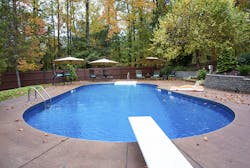What is it?
- Swimming pools, spas and even therapeutic baths are common sources of exposure to contaminants that can cause illness.
- Indoor and outdoor pools have somewhat different health risk issues.
- Contaminant risks primarily include disease-causing microorganisms as well as organic and inorganic chemical disinfectant byproducts (DBPs).
- Numerous disinfectants are used in pools. Forms of chlorine are the most common in the U.S., but bromine forms are also used.
Contamination sources
- Human fluids such as perspiration, surface skin/dirt contamination, urine and fecal matter are the major contaminants of health concern.
- Outdoor pools can be contaminated by bird droppings, algae, dirt, leaves and rain surface runoff.
- Indoor pools are not as exposed, but they have other health concerns, especially from inhalation of airborne contamination.
Health concerns
- Microbial contamination from human and sometimes environmental sources is the greatest health concern.
- Pathogens and illnesses associated with pool water include ear infections, rashes, cryptosporidiosis, giardiasis, bacteria and viruses.
- Exposures occur from ingesting pool water; contact with membranes in the nose, mouth and ears; dermal contact; and inhalation.
- Infectious risks primarily come from ingestion and membrane contact.
- Organic and inorganic DBPs create potential concerns.
- Dermal absorption and the inhalation of volatile organic DBP chemicals are major chemical exposures. Others occur from ingesting water.
- Inhalation exposure to swimmers occurs at the water’s surface-to-air interface. Inhalation also occurs outside the water in indoor pools if ventilation is not efficient. Some studies have found higher blood levels of chloroform after swimming.
- Inorganic and organic chloramines can be dermal, eye and lung irritants.
- Instead of chlorine, trichloramine (NCl3), which is formed from excess chlorine reacting with ammonia, is likely the eye irritant that many people experience.
- Reports have suggested potential allergic type claims from chloramines as well as adverse reactions by asthmatics.
- People with recent gastrointestinal disease/diarrhea, especially children, should not be allowed in swimming pools, and swimmers should shower before entering the pool area to remove surface dirt.
Read more: Maintaining spa water quality is easier than you think
Water treatment
- Pool water treatment and maintenance includes skimming oils and accumulated residues, filtration, recirculation, disinfection and oxidation processes, periodic draining and sanitation, and shock chlorination.
- Common disinfection processes include chlorination (gaseous chlorine, hypochlorite, chlorinated isocyanurates) and bromination (bromochlorodimethylhydantoin, for example). Copper ion has some applications, especially in outdoor pools. Chlorine is not effective against Cryptosporidium contamination.
- Gaseous chlorine costs less but also causes handling and release risks.
- General relative disinfection potencies at equivalent doses are: HOCl ~ HOBr ~ NHxBry >> OCl- > OBr- >> NHxCly.
- Chlorinated isocyanurates are common in outdoor pools because they provide resistance to solar decomposition of chlorine residuals.
- Chlorine residuals are commonly in the range of about 1 part-per-million, and pH should be in the range of 7.2 to 7.8. Regular testing to maintain disinfection residuals and pH is important.
Regulation
- U.S. Centers for Disease Control, the World Health Organization, several pool and spa associations, and state and local health regulations recommend swimming pool treatment and maintenance.
- State and local health departments require inspections and certifications for public pools.
Dr. Joe Cotruvo is president of Joseph Cotruvo and Associates, LLC, Water, Environment and Public Health Consultants. He is a former director of the EPA Drinking Water Standards Division.


